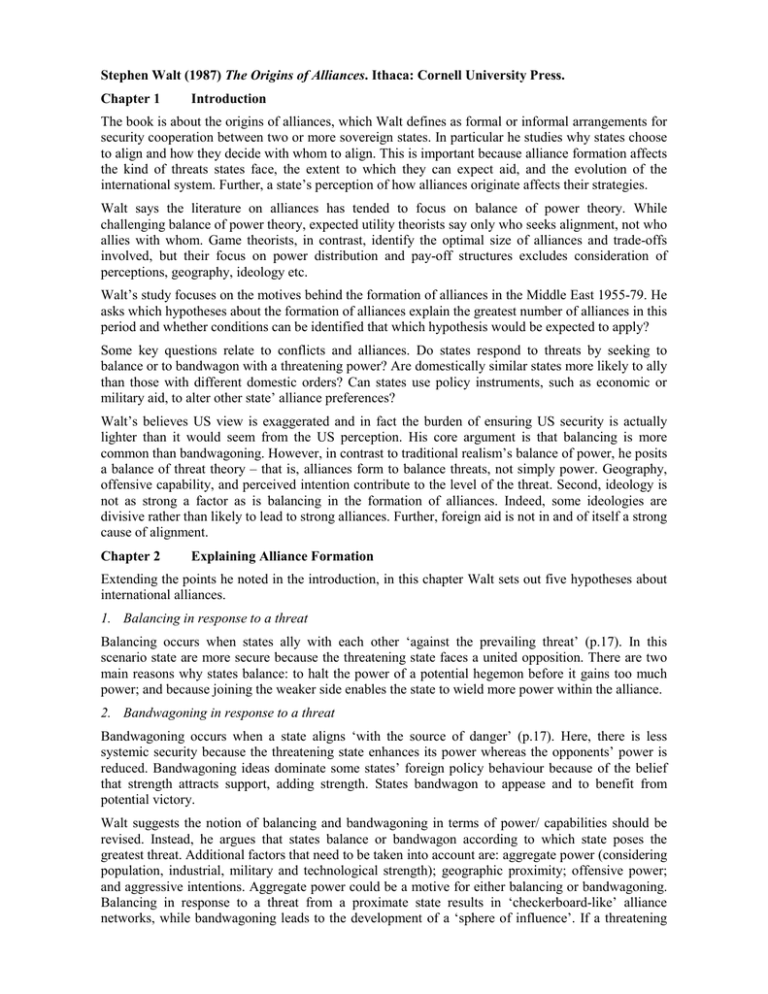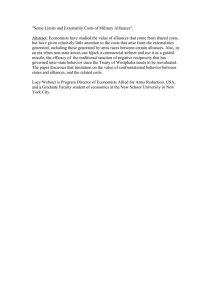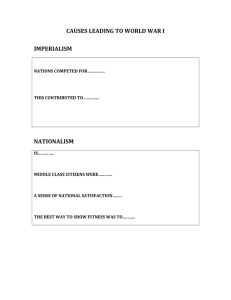The Origins of Alliances, Chapters 1 and 2
advertisement

Stephen Walt (1987) The Origins of Alliances. Ithaca: Cornell University Press. Chapter 1 Introduction The book is about the origins of alliances, which Walt defines as formal or informal arrangements for security cooperation between two or more sovereign states. In particular he studies why states choose to align and how they decide with whom to align. This is important because alliance formation affects the kind of threats states face, the extent to which they can expect aid, and the evolution of the international system. Further, a state’s perception of how alliances originate affects their strategies. Walt says the literature on alliances has tended to focus on balance of power theory. While challenging balance of power theory, expected utility theorists say only who seeks alignment, not who allies with whom. Game theorists, in contrast, identify the optimal size of alliances and trade-offs involved, but their focus on power distribution and pay-off structures excludes consideration of perceptions, geography, ideology etc. Walt’s study focuses on the motives behind the formation of alliances in the Middle East 1955-79. He asks which hypotheses about the formation of alliances explain the greatest number of alliances in this period and whether conditions can be identified that which hypothesis would be expected to apply? Some key questions relate to conflicts and alliances. Do states respond to threats by seeking to balance or to bandwagon with a threatening power? Are domestically similar states more likely to ally than those with different domestic orders? Can states use policy instruments, such as economic or military aid, to alter other state’ alliance preferences? Walt’s believes US view is exaggerated and in fact the burden of ensuring US security is actually lighter than it would seem from the US perception. His core argument is that balancing is more common than bandwagoning. However, in contrast to traditional realism’s balance of power, he posits a balance of threat theory – that is, alliances form to balance threats, not simply power. Geography, offensive capability, and perceived intention contribute to the level of the threat. Second, ideology is not as strong a factor as is balancing in the formation of alliances. Indeed, some ideologies are divisive rather than likely to lead to strong alliances. Further, foreign aid is not in and of itself a strong cause of alignment. Chapter 2 Explaining Alliance Formation Extending the points he noted in the introduction, in this chapter Walt sets out five hypotheses about international alliances. 1. Balancing in response to a threat Balancing occurs when states ally with each other ‘against the prevailing threat’ (p.17). In this scenario state are more secure because the threatening state faces a united opposition. There are two main reasons why states balance: to halt the power of a potential hegemon before it gains too much power; and because joining the weaker side enables the state to wield more power within the alliance. 2. Bandwagoning in response to a threat Bandwagoning occurs when a state aligns ‘with the source of danger’ (p.17). Here, there is less systemic security because the threatening state enhances its power whereas the opponents’ power is reduced. Bandwagoning ideas dominate some states’ foreign policy behaviour because of the belief that strength attracts support, adding strength. States bandwagon to appease and to benefit from potential victory. Walt suggests the notion of balancing and bandwagoning in terms of power/ capabilities should be revised. Instead, he argues that states balance or bandwagon according to which state poses the greatest threat. Additional factors that need to be taken into account are: aggregate power (considering population, industrial, military and technological strength); geographic proximity; offensive power; and aggressive intentions. Aggregate power could be a motive for either balancing or bandwagoning. Balancing in response to a threat from a proximate state results in ‘checkerboard-like’ alliance networks, while bandwagoning leads to the development of a ‘sphere of influence’. If a threatening state’s offensive power renders successful balancing unlikely, states may be more likely to bandwagon. The more unalterably aggressive a state is believed to be, the more likely it is that an alliance will form to balance it. Balancing should be more common than bandwagoning. However, bandwagoning is still a possibility, influenced by several factors: the weaker a state, the more likely it is to bandwagon; states are more likely to bandwagon if they have no allies available; states are more likely to balance in peacetime, but more likely to bandwagon where the outcome of a war begins to look certain. 3. Common ideology as a grounds for alliance formation Realism places less importance on this hypothesis as it sees alliances as more than ‘expedient responses to external threats’ (p.33). The hypothesis is based on the belief that by allying with states with similar beliefs, a state can defend its own political principles; similar states have less reason to fear one another; appearing as part of a large ideological movement can enhance a state’s legitimacy; and the ideology may prescribe alignment. However, some ideologies may cause division, rather than alignment, because of dissension about who should be single leader of the ideology; and disagreement about how to interpret the common ideology. Ideology is most likely to play an important role in alliance formation when the ideology is unifying, not divisive; when state are already quite secure (once security becomes a big issue it is likely to override ideology); when weak/unstable regimes want to enhance their legitimacy. 4. Foreign aid and alliance formation By demonstrating favourable intentions, producing a sense of gratitude and bringing about feelings of dependence on the part of the recipient, military or economic aid can bring about alliances. The donor state particularly increases its leverage when it has a monopoly on the asset supplied, when there is asymmetric dependence between donor and recipient, and when there are fewer domestic constraints on how the donor manipulates the level of assistance provided to the recipient. However, there are several arguments against the importance of ideology. First, foreign aid may occur only where political alignment already exists or is already perceived to be in a state’s interests. Second, aid enhances the recipient’s capabilities, meaning it may be less dependent on the donor and better able to resist pressure. Third, by providing more as a way to prevent defection, donor states lose leverage over their recipient. 5. Alliance formation as a result of transnational penetration Transnational penetration is defined as the ‘manipulation of one state’s domestic political system by another’ (p.46). Transnational penetration is most likely to alter alliance choices (and not just reflect existing preferences) when: when the society being penetrated is open and has a diffuse power structure; when the objectives appear to be limited; and when the means employed appear to be legitimate. The hypotheses suggest quite different prospects for security within the international system. Thus, the subsequent chapters seek to determine which of the hypotheses offers the best explanation of state behaviour.



